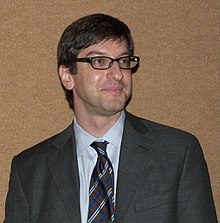David Laibson
David Laibson | |
|---|---|
 David Laibson in 2007. | |
| Born | June 26, 1966 |
| Nationality | American |
| Academic career | |
| Field | Macroeconomics Behavioral economics |
| Institution | Harvard University |
| Alma mater | Massachusetts Institute of Technology London School of Economics Harvard University |
| Doctoral advisor | Olivier Jean Blanchard[1] Roland Bénabou[1] |
| Influences | Benjamin M. Friedman Matthew Rabin |
| Information at IDEAS / RePEc | |
David Isaac Laibson (born June 26, 1966) is a professor of economics at Harvard University, where he has taught since 1994. His research focuses on macroeconomics, intertemporal choice, behavioral economics and neuroeconomics. In 2016, he became chairman of the Harvard economics department.
Laibson is the son of Ruth and Peter Laibson, and grew up in Haverford, Pennsylvania. He received an A.B. (summa) from Harvard in 1988, studying under Benjamin M. Friedman, and went on to study at the London School of Economics (MSc. in Econometrics and Mathematical Economics) where he was a recipient of a Marshall Scholarship. He received his PhD from MIT in 1994 and joined the faculty at Harvard once he graduated. He has since gained tenure. He is married to the mathematician Nina Zipser, and they have a son, Max.
At Harvard, he teaches a popular undergraduate class on "Psychology and Economics." In addition he teaches graduate courses on macroeconomics, behavioral economics and dynamic programming. His research has been published in prestigious journals such as the QJE, AER, JEP, Econometrica, and Science.
Laibson is perhaps best known within economics for his work on time inconsistency, especially his model of quasi-hyperbolic discounting. One of his most prominent early contributions has been the "Golden Eggs and Hyperbolic Discounting" paper in QJE, 1997 where he studied the intertemporal behavior of a time-inconsistent consumer. This work provides a tractable model for self-control problems, in which agents have difficulty sticking to their long-term goals. Agents in Professor Laibson's models generally value "commitment devices," such as 401(k) plans or housing equity, that let them accumulate assets without as much temptation to splurge. These models also explain the "debt puzzle," that American consumers demonstrate both short-run impatience and long-run patience in their lifecycle savings decisions. Laibson has since developed hyperbolic discounting research in many directions, from more advanced theoretical models to computational macroeconomics to conceptual applications.
His own applications of his models have focused primarily on retirement savings, with considerable empirical work on 401(k) plans. He has acquired access to a proprietary dataset of the 401(k) plan account information for several dozen companies, which has let him look empirically at the effects of various 401(k) plan designs and on the investment strategies of the plan participants. Perhaps the most important result to come from this research is that plan participants tend to follow the "path of least resistance," showing remarkable responsiveness to defaults and other context effects from plan design. For example, a company can dramatically increase participation in its 401(k) plan if it moves to a default of automatically enrolling employees in the 401(k) plan unless they take a minor step to opt out. However, the employees tend to stick at the default contribution rates and investment allocations.
Much of this theoretical and empirical work has been co-authored with Brigitte Madrian, James Choi, Andrea Repetto, and Jeremy Tobacman, among many others. Laibson's quasi-hyperbolic discounting models have also been extended and applied to addiction by Matthew Rabin, Ted O'Donoghue, and Jonathan Gruber, among others. Laibson also has written a Principles of Economics textbook with MIT Economist Daron Acemoglu and Chicago Economist John A. List.
Laibson's second most important line of research, after savings and self-control, is models of bounded rationality in markets, generally co-authoring papers with Xavier Gabaix, among others. He has also worked on neuroeconomics.
References
- ^ a b Laibson, David Isaac (1994). Hyperbolic Discounting and Consumption (PDF) (Ph.D.). MIT. Retrieved 1 February 2017.
External links
- The Psychology of Savings and Investment, a series of three talks by David Laibson at the London School of Economics and Political Science, Nov 19–21, 2007.
- 1966 births
- People from Haverford Township, Pennsylvania
- Harvard University alumni
- Alumni of the London School of Economics
- Massachusetts Institute of Technology alumni
- Harvard University faculty
- Living people
- Marshall Scholars
- Fellows of the Econometric Society
- Fellows of the American Academy of Arts and Sciences
- 20th-century economists
- 21st-century economists
